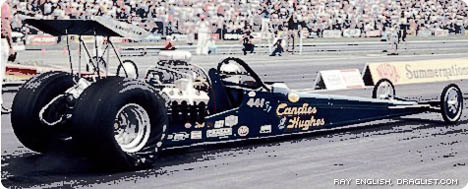
The Golden Years of Drag Racing
A history of one of the world's most popular
motorsports
By Chuck Schifsky/autoMedia.com
It started out as a wild activity practiced by hoodlums in hopped-up cars, but over the course of a few decades, drag racing would ultimately transform itself into one of the world's most popular motorsports. Drag races after World War II were held on military runways, growing out of speed runs (sanctioned and otherwise) on California's dry lakes. Many recognize Goleta Air Base north of Santa Barbara, California as the site of the first organized drag race in 1949. These early drag strips were temporary facilities with no safety barriers or grandstands; just pavement, people and fast cars. Thousands of spectators turned out to watch early racers run 10-second elapsed times (E.T.s) on the measured quarter-mile— a distance chosen because it was about the length of a city block. Most cars were driven to the track or towed to the races on open trailers. Corporate sponsorship and glistening transporter trucks were far in the unimaginable future.
Top Fuelers
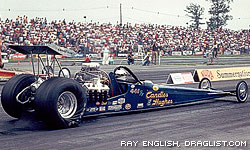 Wally
Parks founded NHRA in 1951, but the sport took a while to get rolling. Even 10 years later, NHRA still only had two competition classes: unmodified Stock or Top Eliminator where anything went. Well, almost anything. In 1957, citing increased cost and danger, and NHRA outlawed nitromethane, which was becoming the popular fuel in Top Eliminator.
Wally
Parks founded NHRA in 1951, but the sport took a while to get rolling. Even 10 years later, NHRA still only had two competition classes: unmodified Stock or Top Eliminator where anything went. Well, almost anything. In 1957, citing increased cost and danger, and NHRA outlawed nitromethane, which was becoming the popular fuel in Top Eliminator.
Wally Parks founded NHRA in 1951, but the sport took a while to get rolling. Even 10 years later, NHRA still only had two competition classes: unmodified Stock or Top Eliminator where anything went. Well, almost anything. In 1957, citing increased cost and danger, and NHRA outlawed nitromethane, which was becoming the popular fuel in Top Eliminator.
With the fuel restriction in effect, the fastest dragsters running in NHRA competition burned gasoline, while most non-NHRA tracks allowed nitro. Two of the best gas dragsters were the Albertson Olds and the Dragmaster Dart. Owned by Dode Martin and Jim Nelson, the Dart was a formidable force and the pair used it as a template to build cars for customers such as Pete Robinson, Roland Leong, and Mickey Thompson.
Perhaps the best remembered part of drag racing in these early days was the low-tech approach of using a flagman to start races. Few sights were as entertaining as a flagman leaping off the ground, waving his green flag as two cars screamed off the line. However, 1963 proved to be a turning point in drag racing's development when tracks replaced flag starters with the electronic "Christmas tree" starting system and NHRA removed its nitro ban. Competition became fairer and NHRA's quickest E.T.s dropped almost a second, while speeds jumped 20 mph. Despite Top Fuel's rebirth, NHRA continued to sanction gas dragsters until 1971, highlighted by twin-engine monsters like the Peters and Frank Freight Train.
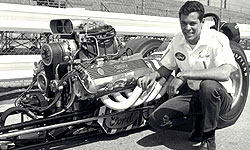 In the early 1960s, Top Fuelers moved from wide and short to long and thin. Wheelbases went from 100 inches to 120 in less than two years as teams struggled for better traction. Smoking the tires for the entire quarter-mile was the norm, but certainly didn't produce the quickest runs. One team that figured this out was Greer-Black-Prudhomme. Led by one of drag racing's savviest tuners, Keith Black, the GBP dragster used a special Schiefer clutch designed to slip just enough to keep from overpowering the rear tires. The car consistently ran 8s, producing an amazing 236 to 7 win-loss record from 1962 through 1964, launching Prudhomme's career as a legendary driver.
In the early 1960s, Top Fuelers moved from wide and short to long and thin. Wheelbases went from 100 inches to 120 in less than two years as teams struggled for better traction. Smoking the tires for the entire quarter-mile was the norm, but certainly didn't produce the quickest runs. One team that figured this out was Greer-Black-Prudhomme. Led by one of drag racing's savviest tuners, Keith Black, the GBP dragster used a special Schiefer clutch designed to slip just enough to keep from overpowering the rear tires. The car consistently ran 8s, producing an amazing 236 to 7 win-loss record from 1962 through 1964, launching Prudhomme's career as a legendary driver.
As drag racing grew during the mid-1960s, it also entered its most colorful era. In addition to NHRA, dozens of organizations promoted or sanctioned races including American Hot Rod Association (AHRA), United Drag Racers Association (UDRA), Professional Dragster Association (PDA), U.S. Fuel and Gas Championships, Pomona Valley Timing Association, and World Series of Drag Racing. Publications such as "Hot Rod Magazine" and "Drag News" with its Mr. Eliminator list brought drag racing to your mailbox long before live TV. Memorable tracks included Lions, Bakersfield, Pomona, Indianapolis, and many more. The best drivers had nicknames including "T.V. Tommy" Ivo, Connie "Bounty Hunter" Kalitta, "Big Daddy" Don Garlits, and Chris "The Golden Greek" Karamesines.
Class Wars
Full-bodied cars were not to be left behind thanks to Detroit manufacturers' involvement. In 1962, NHRA introduced Factory Experimental (FX), signaling the separation between street cars and race cars. It's difficult to tell from today's Super Stock, Pro Stock, and Funny Cars that they're descendents of the same class. After General Motors pulled out of drag racing in 1963, Ford heated up the Super Stock wars in 1964 with its Fairlane Thunderbolt. That same year, Chrysler countered by installing its new 426 Hemi engine in lightweight Dodge and Plymouth bodies. In 1965, Ford switched to FX, while Chrysler built both Super Stockers and FX cars.
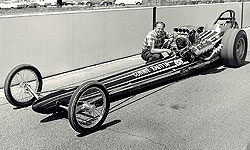 FX cars were highly modified stock vehicles with the front and rear wheels moved forward to shift weight rearward for better traction. Toss in a fiberglass hood, bumpers and fenders; add a nitro-burning engine and you've got an all-out FX car. Some of the hottest early FX cars included "Dyno" Don Nicholson's Comet, the Malco Gasser and
Gas Ronda Mustangs and the Mr. Norm's Dodge. By 1966, the sparse rules allowed manufacturers to build even more radical machines. Mercury led the charge by having Logghe Stamping build four tube chassis cars for different teams around the U.S. Each had a straight front axle and the driver sat in the center. Ford 427 single overhead cam "Cammer" V-8 engines on nitro provided power. Most radical were the one-piece fiberglass bodies— the first ever produced. Without working doors, each Comet body hinged at the rear of the chassis so it could be lifted for the driver to enter—a design still used today on what we now know as Funny Cars.
FX cars were highly modified stock vehicles with the front and rear wheels moved forward to shift weight rearward for better traction. Toss in a fiberglass hood, bumpers and fenders; add a nitro-burning engine and you've got an all-out FX car. Some of the hottest early FX cars included "Dyno" Don Nicholson's Comet, the Malco Gasser and
Gas Ronda Mustangs and the Mr. Norm's Dodge. By 1966, the sparse rules allowed manufacturers to build even more radical machines. Mercury led the charge by having Logghe Stamping build four tube chassis cars for different teams around the U.S. Each had a straight front axle and the driver sat in the center. Ford 427 single overhead cam "Cammer" V-8 engines on nitro provided power. Most radical were the one-piece fiberglass bodies— the first ever produced. Without working doors, each Comet body hinged at the rear of the chassis so it could be lifted for the driver to enter—a design still used today on what we now know as Funny Cars.
But, where did that leave the Super Stock class? Well, even though the Big Three were building some of the hottest cars to ever grace a showroom, there were few Super Stockers built after 1966. The lone exception was the limited run of 1968 Hemi Barracudas and Dodge Darts, many of which still run in Super Stock today. By 1970, NHRA needed a way to keep car manufacturers interested in drag racing as Funny Cars strayed farther from stock vehicles. NHRA's solution was Pro Stock. Unlike Super Stock, which featured cars with stock engines and bodies, Pro Stockers ran radical big-block race engines, yet retained factory bodywork. Popular drivers included Bill "Grumpy" Jenkins, Dick Landy, Sox & Martin, and later, Bob Glidden.
Funny Cars
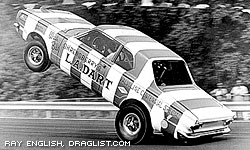 As Funny Cars grew in popularity, Top Fuelers no longer drew big crowds. By 1969, many dragster drivers had switched to Funny Cars. However, a memorable, yet tragic event in March 1970 would change Top Fuel forever. While leaving the starting line at Lions Drag Strip, Don Garlits' front-motored dragster suffered a huge transmission explosion, cutting the car in half and severing Garlits' right foot. What is now regarded as one of drag racing's great defining moments, Garlits decided he'd never drive a dragster with the engine in front again and vowed to build a viable rear-engined car. Even though many tried the rear-engine format, no one had been successful. At the 1971 Winternationals in Pomona, Garlits drove his rear-engined Swamp Rat XIV to the Top Fuel victory. Thanks to Garlits' perseverance and with help from chassis builder Connie Swingle, the two solved steering problems that plagued other rear-engine cars and Top Fuel was changed forever. Within two years, every competitive Top Fuel car had the engine behind the driver.
As Funny Cars grew in popularity, Top Fuelers no longer drew big crowds. By 1969, many dragster drivers had switched to Funny Cars. However, a memorable, yet tragic event in March 1970 would change Top Fuel forever. While leaving the starting line at Lions Drag Strip, Don Garlits' front-motored dragster suffered a huge transmission explosion, cutting the car in half and severing Garlits' right foot. What is now regarded as one of drag racing's great defining moments, Garlits decided he'd never drive a dragster with the engine in front again and vowed to build a viable rear-engined car. Even though many tried the rear-engine format, no one had been successful. At the 1971 Winternationals in Pomona, Garlits drove his rear-engined Swamp Rat XIV to the Top Fuel victory. Thanks to Garlits' perseverance and with help from chassis builder Connie Swingle, the two solved steering problems that plagued other rear-engine cars and Top Fuel was changed forever. Within two years, every competitive Top Fuel car had the engine behind the driver.
By the mid-1970s, drag racing had again advanced. IHRA was launched as a new sanctioning body, while AHRA was fading. Large corporations now sponsored individual Top Fuel and Funny Car teams, allowing them to transition from volunteer help to paid crewmembers, while rolling workshops replaced tiny homebuilt trailers. In 1975, Winston became NHRA's first Series sponsor, helping boost prize money and establishing an annual points fund. For the first time, NHRA had true national champions in each of its nine classes. Drag racing had entered the big time and there was no turning back.
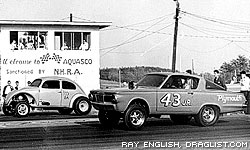 As drag racing entered the 1980s, Funny Cars had surpassed Top Fuel as the most popular class. IHRA dropped Top Fuel altogether and NHRA was having trouble filling 16 car Top Fuel fields. However, this death sentence proved premature. By 1985, Top Fuel was again the fan favorite thanks to sponsors like Mr. Gasket and the return of Don Garlits to NHRA competition after a 5-year absence. By the early 1990s, Funny Car ace Don Prudhomme moved back to Top Fuel and John Force took over as the king of Funny Cars, winning 11 NHRA championships in the process. Kenny Bernstein also made the transition to Top Fuel and recorded the sport's first 300-mph run in 1992, a mark few thought attainable only 10 years earlier. Dragstrips kept pace with car performance by improving track surfaces, while fans enjoyed upgraded spectator amenities. As NHRA celebrated its 50th anniversary in 2001, drag racing has been positioned to remain one of the world's favorite motorsports for years to come.
As drag racing entered the 1980s, Funny Cars had surpassed Top Fuel as the most popular class. IHRA dropped Top Fuel altogether and NHRA was having trouble filling 16 car Top Fuel fields. However, this death sentence proved premature. By 1985, Top Fuel was again the fan favorite thanks to sponsors like Mr. Gasket and the return of Don Garlits to NHRA competition after a 5-year absence. By the early 1990s, Funny Car ace Don Prudhomme moved back to Top Fuel and John Force took over as the king of Funny Cars, winning 11 NHRA championships in the process. Kenny Bernstein also made the transition to Top Fuel and recorded the sport's first 300-mph run in 1992, a mark few thought attainable only 10 years earlier. Dragstrips kept pace with car performance by improving track surfaces, while fans enjoyed upgraded spectator amenities. As NHRA celebrated its 50th anniversary in 2001, drag racing has been positioned to remain one of the world's favorite motorsports for years to come.
© 2003 autoMedia.com Inc. All Rights Reserved.